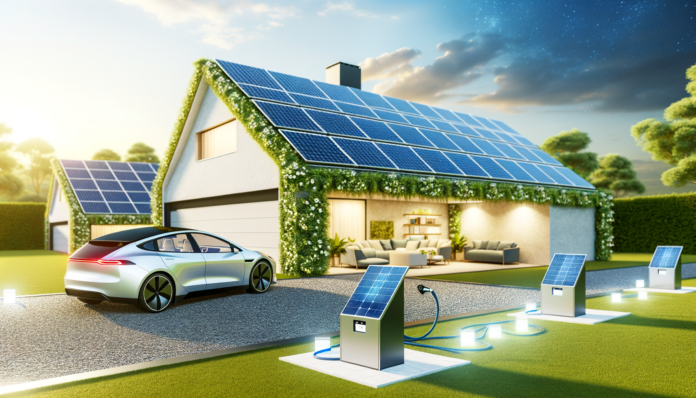Introduction to Emerging Solar Technologies
The Importance of Solar Energy for Sustainable Living
Solar energy is a cornerstone of sustainable living, offering a renewable and environmentally friendly alternative to fossil fuels. As the world grapples with climate change and the depletion of non-renewable energy sources, solar power stands out for its potential to provide clean, abundant, and cost-effective energy. Harnessing the sun’s energy reduces greenhouse gas emissions, mitigates air pollution, and decreases our reliance on finite resources like coal and oil. This transition is crucial for achieving global sustainability goals and ensuring a healthier planet for future generations.
Current Trends in Solar Technology
The solar energy sector is experiencing rapid advancements, driven by technological innovations and increasing demand for clean energy. Some of the most notable trends include:
- Flexible and Lightweight Panels: These panels are designed to be more versatile and easier to install, making solar energy accessible in a variety of settings, from rooftops to portable applications.
- Bifacial Solar Panels: Capable of capturing sunlight on both sides, these panels increase energy yield and efficiency, particularly in environments with reflective surfaces like snow or water.
- Building-Integrated Photovoltaics (BIPV): This technology integrates solar panels into building materials, such as windows and facades, allowing structures to generate their own electricity seamlessly.
- High-Capacity Solar Batteries: Advances in energy storage solutions are enabling more efficient and reliable storage of solar power, addressing the intermittency issue and ensuring a steady energy supply.
- Portable Solar Generators: These compact and mobile units are ideal for off-grid applications, emergency power, and outdoor activities, providing a convenient and sustainable energy source.
Overview of the Article
This article delves into the cutting-edge developments in solar technology that are paving the way for a more sustainable future. We will explore a range of innovative solar panel designs, including flexible and lightweight panels, bifacial solar panels, and building-integrated photovoltaics (BIPV). Additionally, we will examine advancements in solar storage solutions, such as high-capacity solar batteries, portable solar generators, and solar-powered home energy storage systems.
The article will also highlight the growing market for solar-powered gadgets and accessories, from solar chargers for outdoor enthusiasts to wearable solar technology. Furthermore, we will discuss off-grid solar solutions that are transforming remote living, including solar kits, water purification systems, and communication devices.
Finally, we will address the environmental and economic benefits of solar technology, emphasizing its role in reducing carbon footprints, achieving long-term cost savings, and enhancing energy independence and resilience. The article will conclude with a look at future prospects and innovations in solar technology, offering insights into emerging research, potential impacts on sustainable living, and ways to stay updated on the latest advancements in the field.
By the end of this article, readers will have a comprehensive understanding of the latest trends and innovations in solar technology and their significance in promoting sustainable living.
Innovative Solar Panel Designs
Flexible and Lightweight Panels
The advent of flexible and lightweight solar panels marks a significant leap in solar technology. These panels, often made from materials like thin-film photovoltaics, offer a versatile alternative to traditional rigid panels. **Flexible solar panels** can be installed on a variety of surfaces, including those that are curved or uneven, making them ideal for applications where conventional panels would be impractical.
One of the key benefits of these panels is their reduced weight, which simplifies installation and reduces structural load on buildings. This makes them particularly suitable for rooftops that cannot support the weight of traditional solar panels. Additionally, their flexibility allows for innovative applications such as integration into clothing, backpacks, and even vehicles, expanding the possibilities for solar energy use.
Moreover, the production of flexible solar panels often requires less material and energy, contributing to their environmental benefits. As the technology continues to evolve, we can expect further improvements in efficiency and durability, making flexible and lightweight panels a cornerstone of future solar energy solutions.
Bifacial Solar Panels
Bifacial solar panels represent another groundbreaking innovation in the solar industry. Unlike traditional solar panels that capture sunlight only from one side, **bifacial panels** are designed to absorb light from both the front and back. This dual-sided approach significantly increases the amount of energy generated, especially in environments with high albedo, such as snowy or sandy areas where light is reflected off the ground.
The design of bifacial panels typically involves transparent backsheets or dual-glass configurations, allowing sunlight to pass through and be captured by the rear side of the panel. This not only boosts energy output but also enhances the overall efficiency of the solar installation.
In addition to their higher energy yield, bifacial panels are known for their durability and longevity. The use of robust materials ensures that they can withstand harsh environmental conditions, making them a reliable choice for large-scale solar farms and urban installations alike. As the cost of bifacial technology continues to decrease, its adoption is expected to rise, further driving the shift towards more efficient and sustainable solar energy systems.
Building-Integrated Photovoltaics (BIPV)
Building-Integrated Photovoltaics (BIPV) is a revolutionary approach that seamlessly incorporates solar panels into the architecture of buildings. Unlike traditional solar panels that are mounted on rooftops, **BIPV systems** are integrated into the building’s structure, such as facades, windows, and roofs, serving both as building materials and energy generators.
One of the most significant advantages of BIPV is its aesthetic appeal. By blending solar technology with architectural design, BIPV systems can enhance the visual appeal of buildings while providing clean energy. This integration reduces the need for additional land or space for solar installations, making it an ideal solution for urban environments where space is limited.
BIPV systems also contribute to the overall energy efficiency of buildings. For instance, solar windows can provide natural lighting while generating electricity, reducing the need for artificial lighting and lowering energy consumption. Similarly, solar facades can act as thermal insulators, improving the building’s thermal performance and reducing heating and cooling costs.
As the demand for sustainable and energy-efficient buildings grows, BIPV technology is poised to play a crucial role in the future of urban development. With ongoing advancements in materials and design, BIPV systems are becoming more efficient, cost-effective, and versatile, paving the way for a new era of sustainable architecture.
Advancements in Solar Storage Solutions
High-Capacity Solar Batteries
The evolution of high-capacity solar batteries has been a game-changer in the realm of solar energy storage. These batteries are designed to store large amounts of energy generated by solar panels, ensuring a steady supply of electricity even when the sun isn’t shining. **Lithium-ion batteries** are currently the most popular choice due to their high energy density, long lifespan, and decreasing costs. Innovations in battery technology, such as the development of **solid-state batteries**, promise even greater energy storage capabilities, enhanced safety, and faster charging times. These advancements are crucial for both residential and commercial solar energy systems, providing reliable power and reducing dependence on the grid.
Portable Solar Generators
Portable solar generators are becoming increasingly popular, especially among outdoor enthusiasts and those living in remote areas. These compact and lightweight devices harness solar energy to provide a reliable power source on the go. Equipped with **high-efficiency solar panels** and **integrated battery storage**, portable solar generators can power a variety of devices, from smartphones and laptops to small appliances. Their portability and ease of use make them ideal for camping trips, emergency situations, and off-grid living. Additionally, advancements in **solar panel efficiency** and **battery technology** have significantly improved the performance and reliability of these generators, making them a viable alternative to traditional fuel-powered generators.
Solar-Powered Home Energy Storage Systems
Solar-powered home energy storage systems are revolutionizing the way households manage their energy consumption. These systems typically consist of solar panels, an inverter, and a high-capacity battery that stores excess energy generated during the day for use at night or during power outages. **Tesla’s Powerwall** and **LG Chem’s RESU** are among the leading products in this category, offering homeowners the ability to achieve greater energy independence and resilience. The integration of **smart energy management systems** allows for real-time monitoring and optimization of energy usage, further enhancing the efficiency and cost-effectiveness of these storage solutions. As technology continues to advance, we can expect even more sophisticated and affordable home energy storage systems to become available, making sustainable living more accessible to everyone.
Solar-Powered Gadgets and Accessories
Solar Chargers for Outdoor Enthusiasts
In today’s digital age, our dependence on electronic devices is undeniable. However, the limited battery life of these devices often leaves us scrambling for power sources, especially during outdoor activities. **Portable solar chargers** offer a sustainable solution by harnessing renewable energy from the sun. These compact devices convert sunlight into electrical energy, providing a reliable power source for smartphones, tablets, and other gadgets.
Portable solar chargers are particularly beneficial for outdoor enthusiasts. Whether you’re hiking, camping, or traveling, these chargers eliminate the need for electrical outlets, ensuring your devices remain powered. The global market for portable solar chargers is projected to grow significantly, highlighting their increasing economic importance. With advancements in solar technology, these chargers are becoming more efficient and accessible, making them an essential tool for anyone who spends time off the grid.
Solar-Powered Lighting Solutions
Solar-powered lighting solutions are revolutionizing the way we illuminate our surroundings. These lights are not only eco-friendly but also cost-effective, reducing the need for traditional electricity. **Solar-powered lights** come in various forms, including garden lights, streetlights, and even indoor lighting systems.
One of the key advantages of solar-powered lighting is its ability to operate independently of the electrical grid. This makes it ideal for remote areas and emergency situations where conventional power sources may be unavailable. Additionally, solar lights are easy to install and require minimal maintenance, making them a practical choice for both residential and commercial applications.
Solar-powered lighting solutions also contribute to reducing carbon footprints. By utilizing renewable energy, they help decrease greenhouse gas emissions and promote a more sustainable lifestyle. As technology advances, we can expect even more innovative and efficient solar lighting options to become available.
Wearable Solar Technology
Wearable solar technology is an exciting frontier in the realm of renewable energy. This innovative approach integrates solar panels into clothing and accessories, allowing individuals to generate power on the go. **Solar-powered wearables** include items like solar backpacks, jackets, and even watches.
These wearables are designed to capture sunlight and convert it into electrical energy, which can then be used to charge small devices like smartphones and fitness trackers. The convenience of having a portable power source integrated into everyday items makes wearable solar technology particularly appealing.
Moreover, wearable solar technology aligns with the growing trend of sustainable fashion. By incorporating renewable energy into clothing, manufacturers can reduce the environmental impact of their products. This not only benefits the planet but also appeals to eco-conscious consumers looking for innovative ways to reduce their carbon footprint.
In conclusion, solar-powered gadgets and accessories are transforming the way we interact with technology and the environment. From portable solar chargers to solar-powered lighting solutions and wearable solar technology, these innovations offer practical and sustainable alternatives to traditional power sources. As we continue to embrace these advancements, we move closer to a future where renewable energy is seamlessly integrated into our daily lives.
Off-Grid Solar Solutions
Solar Kits for Remote Living
Solar kits have become a game-changer for individuals and communities living in remote areas. These kits typically include solar panels, batteries, inverters, and essential wiring, providing a comprehensive solution for generating and storing solar energy. **Solar kits** are designed to be user-friendly, making them accessible even to those with limited technical knowledge. They offer a reliable source of electricity for lighting, cooking, and powering small appliances, significantly improving the quality of life in off-grid locations.
One of the key advantages of solar kits is their **portability** and **ease of installation**. They can be set up quickly and do not require extensive infrastructure, making them ideal for temporary setups or emergency situations. Additionally, solar kits are scalable, allowing users to expand their systems as their energy needs grow. This flexibility makes them a sustainable and cost-effective solution for remote living.
Solar Water Purification Systems
Access to clean water is a critical issue in many remote and underdeveloped regions. Solar water purification systems offer an innovative solution by harnessing solar energy to purify water. These systems use solar panels to power pumps and filtration units, which remove contaminants and pathogens from water sources. Some advanced systems also incorporate **solar thermal technology** to distill water, providing an additional layer of purification.
The benefits of solar water purification systems are manifold. They are **environmentally friendly**, as they do not rely on fossil fuels or produce harmful emissions. Moreover, they are **cost-effective** in the long run, reducing the need for expensive and logistically challenging fuel supplies. By providing a reliable source of clean water, these systems can significantly improve health outcomes and reduce the incidence of waterborne diseases in remote communities.
Solar-Powered Communication Devices
In remote areas, communication is often a major challenge due to the lack of reliable power sources. Solar-powered communication devices, such as satellite phones, radios, and Wi-Fi hotspots, are bridging this gap. These devices are equipped with solar panels that charge their batteries, ensuring continuous operation even in the absence of a traditional power grid.
**Solar-powered communication devices** are crucial for emergency response and disaster management. They enable real-time communication and coordination, which can be lifesaving in critical situations. Additionally, they support educational and economic activities by providing access to information and connectivity. For instance, solar-powered Wi-Fi hotspots can facilitate online learning and remote work, opening up new opportunities for people in isolated regions.
In summary, off-grid solar solutions like solar kits, water purification systems, and communication devices are transforming lives in remote areas. They offer sustainable, reliable, and cost-effective alternatives to traditional energy sources, promoting **energy independence** and **resilience**. As these technologies continue to evolve, they hold the promise of further enhancing the quality of life and fostering sustainable development in off-grid communities.
Environmental and Economic Benefits of Solar Technology
Reducing Carbon Footprint
One of the most significant environmental benefits of solar technology is its ability to reduce the carbon footprint. Unlike fossil fuels, which release large amounts of carbon dioxide (CO2) and other greenhouse gases into the atmosphere, solar energy generates electricity without emitting harmful pollutants. This reduction in greenhouse gas emissions is crucial for mitigating climate change and improving air quality. By harnessing the power of the sun, solar technology helps to decrease the reliance on coal, oil, and natural gas, which are major contributors to global warming and environmental degradation.
Long-Term Cost Savings
Solar technology not only benefits the environment but also offers substantial economic advantages. One of the primary economic benefits is the long-term cost savings associated with solar energy systems. Although the initial investment in solar panels and installation can be significant, the long-term savings on energy bills can be substantial. Solar panels have a lifespan of 25-30 years, during which they can generate free electricity from sunlight. This reduces or even eliminates monthly electricity bills, providing significant savings over time. Additionally, many governments offer incentives, tax credits, and rebates to encourage the adoption of solar technology, further reducing the overall cost.
Energy Independence and Resilience
Solar technology also enhances energy independence and resilience. By generating electricity locally, solar energy reduces the dependence on imported fossil fuels, which can be subject to price volatility and supply disruptions. This energy independence is particularly beneficial for remote or off-grid areas where access to traditional energy sources is limited. Moreover, solar energy systems can be paired with battery storage solutions to provide a reliable and resilient power supply. In the event of power outages or natural disasters, solar-powered homes and businesses can continue to operate, ensuring a continuous supply of electricity and enhancing community resilience.
In summary, the environmental and economic benefits of solar technology are profound. By reducing carbon emissions, offering long-term cost savings, and enhancing energy independence and resilience, solar energy plays a crucial role in promoting sustainable living and addressing the global challenges of climate change and energy security.
Future Prospects and Innovations in Solar Technology
Emerging Research and Development
The field of solar technology is witnessing rapid advancements, driven by continuous research and development. One of the most promising areas is the development of perovskite solar cells. These cells offer high efficiency and low production costs, making them a potential game-changer in the solar industry. Researchers are also exploring tandem solar cells, which combine different materials to capture a broader spectrum of sunlight, thereby increasing overall efficiency.
Another exciting development is the integration of solar technology with other renewable energy sources. Hybrid systems that combine solar with wind or hydro power are being designed to provide more reliable and consistent energy output. Additionally, advancements in solar tracking systems, which adjust the position of solar panels to follow the sun, are significantly improving energy capture and efficiency.
Potential Impact on Sustainable Living
The innovations in solar technology have far-reaching implications for sustainable living. Firstly, the increased efficiency and reduced costs of new solar technologies make renewable energy more accessible to a broader population. This democratization of energy can lead to significant reductions in greenhouse gas emissions, helping to combat climate change.
Moreover, the integration of solar technology into everyday life is becoming more seamless. Building-integrated photovoltaics (BIPV) allow for solar panels to be incorporated into the very fabric of buildings, such as roofs and windows, without compromising aesthetics. This not only reduces energy costs but also enhances the energy efficiency of buildings, contributing to sustainable urban development.
In rural and remote areas, off-grid solar solutions are providing reliable and clean energy, improving the quality of life and economic opportunities for communities that previously had limited access to electricity. Solar-powered water purification systems and communication devices are also playing a crucial role in enhancing public health and connectivity in these regions.
How to Stay Updated on Solar Innovations
Staying informed about the latest advancements in solar technology is crucial for both industry professionals and enthusiasts. Here are some effective ways to keep up-to-date:
- Industry Publications and Journals: Subscribing to leading industry publications such as “Solar Energy Journal” and “Renewable Energy World” can provide in-depth articles and research findings.
- Conferences and Webinars: Attending conferences like the Solar Power International (SPI) and participating in webinars hosted by organizations such as the International Renewable Energy Agency (IRENA) can offer valuable insights and networking opportunities.
- Online Courses and Certifications: Platforms like Coursera and edX offer courses on solar energy and renewable technologies, which can help deepen your understanding and keep you updated on the latest trends.
- News Websites and Blogs: Websites like CleanTechnica and GreenTech Media regularly publish news and analysis on the latest developments in solar technology.
- Social Media and Forums: Following industry experts and organizations on social media platforms like LinkedIn and Twitter, and participating in forums such as Reddit’s r/solar, can provide real-time updates and community discussions.
By leveraging these resources, individuals and businesses can stay ahead of the curve, ensuring they are well-informed about the latest innovations and trends in solar technology. This knowledge can empower them to make informed decisions and contribute to the broader adoption of sustainable energy solutions.






